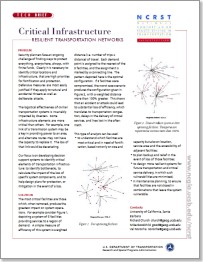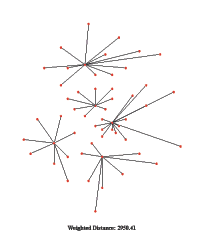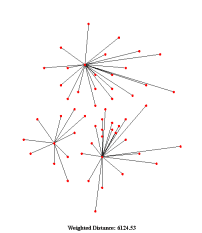

|
Facilities and services can be lost due to natural disasters or intentional
strikes, either by terrorism or an army. An intentional strike against a
communication or delivery system is called interdiction. The logistical effectiveness
of civilian transportation systems may be substantially impacted by interdiction,
and understanding the implications is essential to security planning.
Some infrastructure elements are more critical than others. For example,
one link of a transmission system may be a key in providing power to an area,
and alternate routes may not have the capacity to replace it. The loss of
that link could be devastating.
Our focus is on developing decision support systems to identify critical
infrastructure, to identify bottlenecks, to calculate the impact of the loss
of specific system components, and to help design a plan of mitigation in
the event of a loss.

|
| Figure 1. Five operating facilities. Weighted distance: 2950. |
The most critical facilities are those which, when removed, produce the
greatest impact on system operations. For example consider Figure 1, depicting
a system of 5 facilities providing services to a region of demand.
The efficiency of this system is measured in terms of weighted distance
(e.g. trips x miles) of travel. Each demand is assigned to the nearest of
the 5 facilities and the assignment is marked by a connecting line. The pattern
depicted here is the optimal configuration. If 2 facilities were compromised,
the worst case scenario produces the configuration given in Figure 2,
with a weighted distance more than 100% greater.

|
| Figure 2. Three operating facilities. Weighted distance: 6124. |
Researchers are developing analysis tools that can be used to model possible
impacts due to interdiction and natural disasters. The objectives of
this research are:
Richard Church, church@geog.ucsb.edu
Paola Scaparra, paola@geog.ucsb.edu
University of California, Santa Barbara